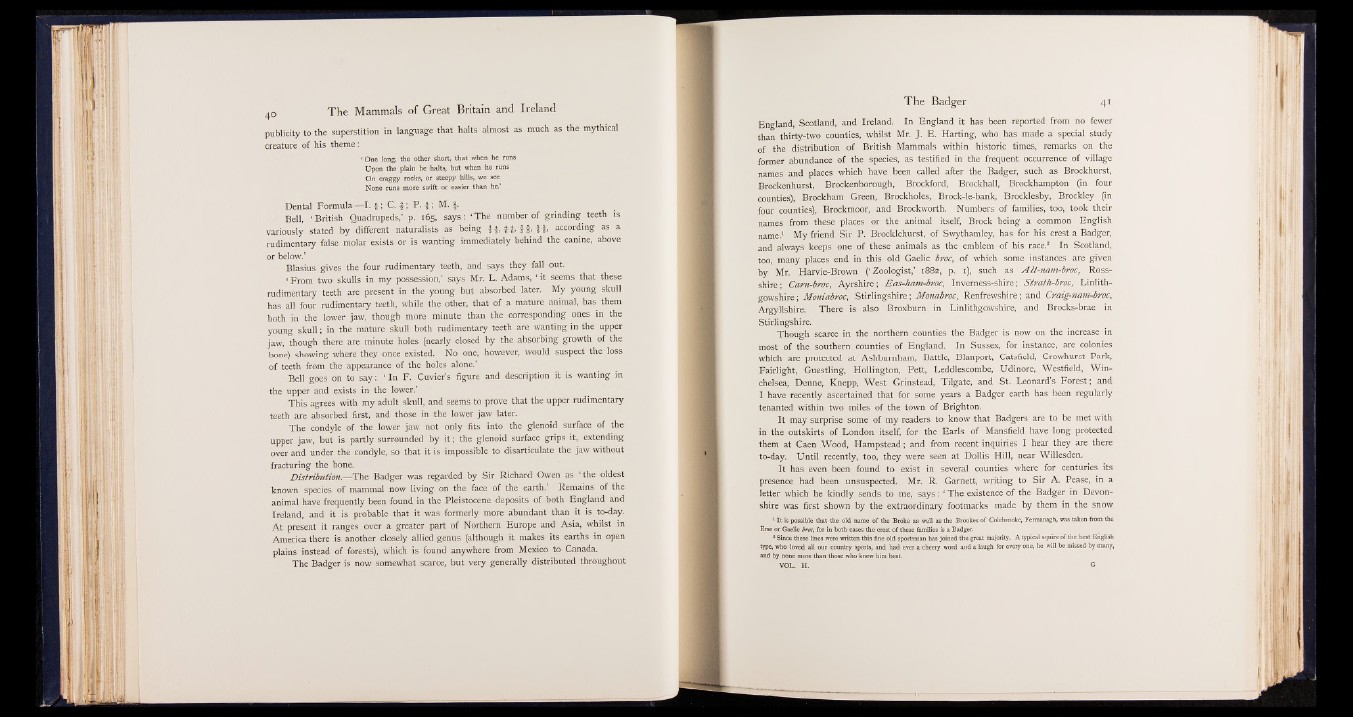
publicity to the superstition in language that halts almost as much as the mythical
creature of his theme:
‘ One long, the other short, that when he runs
Upon the plain he halts, but when he runs
On craggy rocks, or steepy hills, we see
None runs more swift or easier than he.’
Dental Formula—I. f ; C. f ; P. f ; M. £.
Bell, ‘ British Quadrupeds,’ p. 165, says: ‘ The number of grinding teeth is
variously stated by different naturalists as being ££> H> according as a
rudimentary false molar exists or is wanting immediately behind the canine, above
or below.’
Blasius gives the four rudimentary teeth, and says they fall out.
‘ From two skulls in my possession,’ says Mr. L. Adams, ‘ it seems that these
rudimentary teeth are present in the young but absorbed later. My young skull
has all four rudimentary teeth, while the other, that of a mature animal, has them
both in the lower jaw, though more minute than the corresponding ones in the
young skull; in the mature skull both rudimentary teeth are wanting in the upper
jaw, though there are minute holes (nearly closed by the absorbing growth of the
bone) showing where they once existed. No one, however, would suspect the loss
of teeth from the appearance of the holes alone.’
Bell goes on to s a y : ‘ In F . Cuvier’s figure and description it is wanting in
the upper and exists in the lower.’
This agrees with my adult skull, and seems to prove that the upper rudimentary
teeth are absorbed first, and those in the lower jaw later.
The condyle of the lower jaw not only fits into the glenoid surface of the
upper jaw, but is partly surrounded by i t ; the glenoid surface grips it, extending
over and under the condyle, so that it is impossible to disarticulate the jaw without
fracturing the bone.
D istribution.—The Badger was regarded by Sir Richard Owen as ‘ the oldest
known species of mammal now living on the face of the earth.’ Remains of the
animal have frequently been found in the Pleistocene deposits of both England and
Ireland, and it is probable that it was formerly more abundant than it is to-day.
At present it ranges over a greater part of Northern Europe and Asia, whilst in
America there is another closely allied genus (although it makes its earths in open
plains instead of forests), which is found anywhere from Mexico to Canada.
The Badger is now somewhat scarce, but very generally distributed throughout
England, Scotland, and Ireland. In England it has been reported from no fewer
than thirty-two counties, whilst Mr. J. E . Harting, who has made a special study
of the distribution of British Mammals within historic times, remarks on the
former abundance of the species, as testified in the frequent occurrence of village
names and places which have been called after the Badger, such as Brockhurst,
Brockenhurst, Brockenborough, Brockford, Brockhall, Brockhampton (in four
counties), Brockham Green, Brockholes, Brock-le-bank, Brocklesby, Brockley (in
four counties), Brockmoor, and Brockworth. Numbers of families, too, took their
names from these places or the animal itself, Brock being a common English
name.1 My friend Sir P. Brocklehurst, of Swythamley, has for his crest a Badger,
and always keeps one of these animals as the emblem of his race.2 In Scotland,
too, many places end in this old Gaelic broc, of which some instances are given
by Mr. Harvie-Brown (‘ Zoologist,’ 1882, p. 1), such as AIt-nam-broc, Ross-
shire; Carn-broc, Ayrshire; Eas-ham-broc, Inverness-shire; Strath-broc, Linlithgowshire;
Moniabroc, Stirlingshire; Monabroc, Renfrewshire; and Craig-nam-broc,
Argyllshire. There is also Broxburn in Linlithgowshire, and Brocks-brae in
Stirlingshire.
Though scarce in the northern counties the Badger is now on the increase in
most of the southern counties of England. In Sussex, for instance, are colonies
which are protected at Ashburnham, Battle, Blanport, Catsfield, Crowhurst Park,
Fairlight, Guestling, Hollington, Pett, Leddlescombe, Udinore, Westfield, Win-
chelsea, Denne, Knepp, West Grinstead, Tilgate, and St. Leonard’s Forest; and
I have recently ascertained that for some years a Badger earth has been regularly
tenanted within two miles of the town of Brighton.
It may surprise some of my readers to know that Badgers are to be met with
in the outskirts of London itself, for the Earls of Mansfield have long protected
them at Caen Wood, Hampstead; and from recent inquiries I hear they are there
to-day. Until recently, too, they were seen at Dollis Hill, near Willesden.
It has even been found to exist in several counties where for centuries its
presence had been unsuspected. Mr. R. Garnett, writing to Sir A. Pease, in a
letter which he kindly sends to me, s ay s : ‘ The existence of the Badger in Devonshire
was first shown by the extraordinary footmarks made by them in the snow
1 It is possible that the old name of the Broke as well as the Brookes of Colebrooke, Fermanagh, was taken from the
Erse or Gaelic broc, for in both cases the crest of these families is a Badger.
2 Since these lines were written this fine old sportsman has joined the great majority. A typical squire of the best English
type, who loved all our country sports, and had ever a cheery word and a laugh for every one, he will be missed by many,
and by none more than those who knew him best.
VOL. II. G